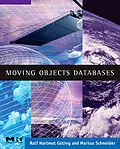Moving Objects Databases is the first uniform treatment of moving objects databases, the technology that supports GPS and RFID. It focuses on the modeling and design of data from moving objects - such as people, animals, vehicles, hurricanes, forest fires, oil spills, armies, or other objects - as well as the storage, retrieval, and querying of that very voluminous data. It includes homework assignments at the end of each chapter, exercises throughout the text that students can complete as they read, and a solutions manual in the back of the book. This book is intended for graduate or advanced undergraduate students. It is also recommended for computer scientists and database systems engineers and programmers in government, industry and academia; professionals from other disciplines, e.g., geography, geology, soil science, hydrology, urban and regional planning, mobile computing, bioterrorism and homeland security, etc. - Focuses on the modeling and design of data from moving objects--such as people, animals, vehicles, hurricanes, forest fires, oil spills, armies, or other objects--as well as the storage, retrieval, and querying of that very voluminous data. - Demonstrates through many practical examples and illustrations how new concepts and techniques are used to integrate time and space in database applications. - Provides exercises and solutions in each chapter to enable the reader to explore recent research results in practice.
Autorentext
Ralf Hartmut Güting is Professor of computer science at the University of Hagen, Germany. After a one-year visit to the IBM Almaden Research Center in 1985, extensible and spatial database systems became his major research interests. He is the author of two German textbooks on data structures/algorithms and on compilers and has published about 50 articles on computational geometry and database systems. He is an associate editor of ACM Transactions on Database Systems.
Klappentext
Moving Objects Databases is the first uniform treatment of moving objects databases, the technology that supports GPS and RFID. It focuses on the modeling and design of data from moving objects - such as people, animals, vehicles, hurricanes, forest fires, oil spills, armies, or other objects - as well as the storage, retrieval, and querying of that very voluminous data.
It includes homework assignments at the end of each chapter, exercises throughout the text that students can complete as they read, and a solutions manual in the back of the book.
This book is intended for graduate or advanced undergraduate students. It is also recommended for computer scientists and database systems engineers and programmers in government, industry and academia; professionals from other disciplines, e.g., geography, geology, soil science, hydrology, urban and regional planning, mobile computing, bioterrorism and homeland security, etc.
- Focuses on the modeling and design of data from moving objects--such as people, animals, vehicles, hurricanes, forest fires, oil spills, armies, or other objects--as well as the storage, retrieval, and querying of that very voluminous data.
- Demonstrates through many practical examples and illustrations how new concepts and techniques are used to integrate time and space in database applications.
- Provides exercises and solutions in each chapter to enable the reader to explore recent research results in practice.
Inhalt
Introduction
Spatio-Temporal Databases in the Past
Modeling and Querying Current Movement
Modeling and Querying History of Movement
Data Structures and Algorithms for Moving Objects Types
The Constraint Database Approach
Spatio-Temporal Indexing.
